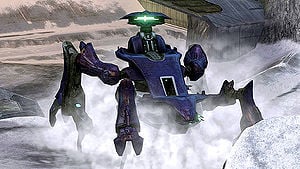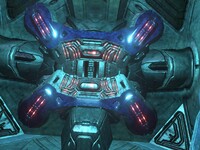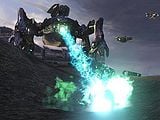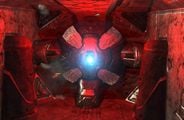Deutoros-pattern Scarab: Difference between revisions
From Halopedia, the Halo wiki
Matoro3311 (talk | contribs) (Undo revision 689509 by 96.4.127.20 (talk) {Poor grammar}) |
|||
| Line 133: | Line 133: | ||
*'''(1) Front-Mounted Cannon''' | *'''(1) Front-Mounted Cannon''' | ||
* | *'''Ammo''': Super-Heated Plasma, presumably unguided. | ||
*'''Rate of Fire''': 4 second stream; 30 to 40 per second | *'''Rate of Fire''': 4 second stream; 30 to 40 per second | ||
*'''Movement of cannon''': Through careful examination, one can see that the inside gun part seems to move forward from a cradle as the flaps open up. | *'''Movement of cannon''': Through careful examination, one can see that the inside gun part seems to move forward from a cradle as the flaps open up. | ||
Revision as of 15:51, December 8, 2008
| This article does not meet the wiki's general standards and/or standards on layouts. You can help by cleaning this article. |
Template:Ratings Template:Ship
The Type-47 Ultra Heavy Assault Platform (abbreviated Type-47 UHAP), more commonly known as the Scarab, is a Covenant ground based heavy assault walker.
Introduction
Scarabs are movable fortresses on the field and the Covenant use them to the best of its abilities. The Scarab is meant to assault heavily defended structures and barriers and to give quick unstoppable support for Covenant troops on the ground. It can also deliver Covenant ground troops to their destination through heavily defended areas; this could mean death for the defending troops, such as the UNSC Marines. Unlike almost all Covenant ground vehicles, the Scarab does not make use of a Boosted Gravity Propulsion Drive for movement. Instead, it uses four large, powerful legs to traverse terrain most vehicle's cannot, including climbing over buildings, trenches, mountains and other obstacles.
The Scarab can hold squads of Grunts and Jackals, as well as a few Brutes or Elites to prevent it from it being boarded, if anything managed to get close enough. They have been used in many battles against enemies, such the Battle of Reach, both battles of Earth and the Battle of the Ark. If a Scarab did get boarded, and there were no surviving Covenant troops on board, the Scarab could be destroyed by destroying its vulnerable reactor.
The Scarab is also the largest known Covenant ground vehicle, as well as the most powerful, being equipped with a powerful plasma beam cannon at the front on a "head"-like pivot, and dorsally-mounted anti-air cannons. Despite its size, weaponry, and extremely thick armor, the craft remains vulnerable to boarding actions, and if the crew and central core are eliminated, the Scarab will detonate.[1]
Scarabs are quite notable for their intimidating, spider-like appearance, large size, and massive firepower. Their legs are surprisingly swift and accurate for their size, and were even able to find holds in narrow places, such as a canyon on Installation 05 or the streets of Mombasa. These legs can also be used for weapons, as a monstrous pointed leg is able to crush anything that happens to get in its way, such as a truck. A Scarab's legs can be destroyed with enough firepower.
Variation
Halo Graphic Novel
In the Halo Graphic Novel, the Scarab had a very different appearance from the two game variants with a roughly cross shaped body, the across sections bearing dual cannons, and neither end having a visible plasma cannon.
Its legs were a distinctly different shape (straight, with an 'L'-shaped joint to the body). It should be noted, however, that the story in which it appears, Second Sunrise Over New Mombasa, uses a very large amount of artistic license. The story is canonical (it was authorized by Bungie), but the visuals of the story clearly are not.
Halo 2
- "We've all run the simulations. They're tough, but they ain't invincible."
- — Avery J. Johnson to several marines in Halo 2
The Scarab was first seen in Halo 2 level Metropolis, and appeared as a large, four legged, silver armored behemoth with an estimated height of ninety feet. It featured a deck on top that was guarded by numerous Elites, Jackals and Grunts along with a walkway going over the entrance to its control room. There were two spine mounted plasma cannons to provide anti-air defense.
Its shell was invulnerable to damage from 90mm shells, missiles, .50 cal rounds, and ANVIL HE missiles (the armor could be similar to the ship plating the Covenant use on their starships). It proved vulnerable to boarding actions and destruction from inside. Bungie has joked that this Scarab looks more like a basket than an actual assault platform.Also this scarab didn't have the plasma turret on top like the halo 3 version. It was likely that this scarab was more of a transport for weaker soldiers because of all elites, jackals, and grunts that were giving cover fire for the pilots inside.
Halo 3
The Scarab received major changes between Halo 2 and Halo 3, with the Scarab actually being able to be destroyed, as opposed to just killing all of the enemies inside, as seen in a Halo 2 cutscene. The Halo 2 Scarab was also piloted by a Covenant soldier, whereas the Halo 3 Scarab is controlled by a concentration of Lekgolo worms in the reactor. Appearance wise, its body was changed to have a different shape, being more bulbous at the end, similar to the Wraiths of Halo: Combat Evolved. In Halo 3, it seemed to have a greater width than in Halo 2, but wasn’t as tall as previously. The Scarab in Halo 3 is also a different color than Halo 2's variant, being purple instead of blue.
In terms of weaponry, it wielded a smaller plasma beam that seems weaker (On Legendary the player is able to withstand sustained fire for a short amount of time [approx 0.8s]), as opposed to the instant death of the Halo 2 Scarab gun). The two anti-air turrets were removed for Halo 3, having been replaced by a single, large turret at the rear (which would shoot at you if you were in a Hornet or Banshee, and you were able to shoot off the covering of it with Hornet rockets.)
The flaps on the plasma beam were removed, and replaced by two destructible stationary plates. As pointed out before, the Scarab now appears to have no crew controlling it and it is currently thought to be controlled by Lekgolo worms. This has been proven in the December issue of GameInformer, in an article on the Mythic map pack. The level "Assembly" was shown to be a Scarab factory, and it was stated that tubes could be clearly seen on the level, injecting the worms into the Scarab shells.
The main gun also changed, with it appearing like a hose in Halo 3, instead of just the straight beam appearance of Halo 2. The Scarab appeared to have high impact legs due to all the jumps it makes, and it appears to be more maneuverable than in Halo 2. In Halo 3, it no longer dripped coolant/extra plasma from its belly/muzzle (gun) area and, finally, it had a darker color than in Halo 2.
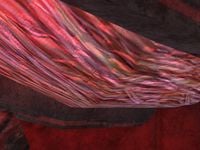
A likely conjecture is that this version of the Scarab was intended to be a weapon. Its color changed to a shade of purple, like other Covenant war-ready vehicles and it was better-defended, having superior weapons. It has been speculated that Scarabs of Halo 2 were not weapons, but rather mining tools that were deployed as emergency combat relief by Regret upon finding humans on Earth. They could have been the mining Scarabs from Fall Of Reach. This is supported by the fact that Regret was looking for the device that opened the Portal to the Ark, and he needed digging machines to excavate it. Another likely explanation for the different Scarabs encountered throughout Halo is that the Scarabs depicted in Halo 2, the Graphic Novels and Halo wars were older models of Scarab tank, while the one encountered in Halo 3 was a newer model designed to replace the older versions.
Differences aside, it still had many similarities to the old Scarab. There were three levels (or decks), and the lowest was accessible when the Scarab had been temporarily disabled. This level featured a Grunt-mounted Plasma Turret, and usually one to four Brutes, depending on the difficulty level. There was a ramp that led to the second level, where there were a varying number of enemies, depending on the level and difficulty. Usually, you could expect to find a few Brutes and Grunts. On this level, there were two more Plasma Turrets, aimed to either side of the Scarab. If you turned 180° immediately upon ascending the ramp to this level, you could go up the purple slope to the third tier. This was just an open, unprotected platform below the large turret. Past the turrets on the second level (round the corner) is the power core that must be destroyed to have taken down the Scarab.
Bungie had also stated in the September issue of EGM, that the Scarab used an unscripted game Artificial Intelligence (not to be confused with story artificial intelligence units like Cortana) to create a more dynamic battle with it, as it would roam across the battlefield of its own accord and attack targets in its path. This way it would no longer require a relatively easy boarding action every time but a tactical approach.
Halo Wars
In Halo Wars, the Scarab seemed to be a combination of the Halo 2 and Halo 3 Scarab designs, featuring an encased, Covenant purple chassis with a single spine mounted plasma cannon. The flaps on its Assault Cannon, while bearing a similarity to those of the Halo 3 Scarab and also resembling a beak of a bird, operated like the flaps of the Halo 2 Scarab gun. They first concealed the weapon then before it folded out into 8 separate pieces and seemed to shoot a sustained stream of plasma fire. The cannon was described in the demonstration as "An anti-everything cannon".
In the most recent iterations of Halo Wars, however, the Scarab seems to more closely the Halo 3 variant, rather than the Halo 2 model, however, this could just be an upgrade or a future technological advancement. It also seems to be much smaller than previous Scarabs. A recent article in Xbox Magazine comments that an attacking Scarab "ripped (a UNSC base) a new one."
List of Destructible Parts
Halo 3
There are far more destructible parts on the Halo 3 Scarab than the Halo 2 Scarab.
- All four of the Scarab's knees were destructible to the point that the Scarab temporarily buckled under the weight of the platform. The armor on these legs could also be blown off.
- The flaps covering the Scarab's main gun could be destroyed. This did not, however, disable the weapon.
- The crest on and around the turret could be completely blown off, slowing the rate of fire and the size of the plasma bolts. This had been reported to temporarily disable the turret.
- Two side door panels near the bottom rear could be torn off to allow a singular entry.
- The barrier protecting the Core could be ripped away from the back of the Scarab by shooting the red glowing circle at the top of the barrier. Doing so would result in the Core being completely exposed, making it easier to destroy.
- All three Plasma Cannons.
- The Core.
Note: If you destroy the Core, all parts of the Scarab will be destroyed at once, except for the crest of the Scarab Gun.
Halo 2
Unlike the Halo 3 Scarab, the Halo 2 Scarab was almost indestructible and immune to damage in-game. It was only destroyed in a cutscene. It should also be noted that the Scarab in the level The Great Journey seemed to be damaged under the main gun; as it fired, green plasma leaked out onto the ground.
- The forward Plasma Turret.
- The rear Plasma Turret.
- The plating on the main gun. Note: This took an incredible amount of damage and was only possible using the tank glitch.
- The underside grate.
Weaponry
Primary
- (1) Front-Mounted Cannon
- Ammo: Super-Heated Plasma, presumably unguided.
- Rate of Fire: 4 second stream; 30 to 40 per second
- Movement of cannon: Through careful examination, one can see that the inside gun part seems to move forward from a cradle as the flaps open up.
- Notes: The projectile emitted from the Scarab's main gun emits a neon-green/bluish glow, indicating extremely high temperature. As the gun fires, white, hot liquid pours from the barrel onto the ground. The gun's force is enough to destroy any vehicle smaller than the Scarab in a matter of seconds. Also, on easy or normal difficulty, if you are in a small vehicle (Mongoose, Warthog, Ghost, Chopper) the sheer force of the plasma stream hitting the ground will flip your vehicle if you are close enough. If this happens close to the Scarab it may step on (and destroy) your vehicle.
- Approx. Range: The effective range on a Scarab's main cannon is not exceptionally good, about 0.4 miles as seen during the Citadel and Cartographer battles, where its attack can easily be evaded if at a distance.
Secondary
- Mounted Anti-Aircraft Turrets (Two in Halo 2, One in Halo 3)
- Ammo: Super-Heated Plasma, (similar to Shielded Plasma Cannon)
- Rate of Fire: 400-600 rounds/minute
- Notes: Presumed computer controlled, but a close look indicates that it may be manually controlled. It does wildly spin around when the core is destroyed as if the automatic controls crashed. Could be shot off with little firepower. NOTE: In Halo 3 the Anti Aircraft cannon couldn’t be shot off and was invincible. The Anti Aircraft gun(s) were unsurprisingly extremely effective against aircraft.
- Approx. Range: These weapons have a much greater range than the primary cannon on the Scarab. They are extremely effective against airborne vehicles, but can also be used against ground-based vehicles, such as Warthogs or Scorpions. They are effective up to approximately 1.5 miles, which is a rough but evidence-based conclusion drawn from ships and vehicles with similar weaponry.
Strategies
See page Scarab Fighting Strategies for a list of tactics to use against both Halo 2 and Halo 3 Scarabs.
Character Compatibility
- Elites (Halo 2 only)
- Sergeant Avery Johnson (Halo 2 only)
- Brutes (Halo 3 only)
- Lekgolo (confirmed pilots and part of the core system of Scarabs in Halo 3)
- Grunts - passengers, use as platform for plasma cannon
- Jackals - passengers
Glitches
- During the level The Ark, if you kill everyone (including allies) and jump on the scarab whatever way you will go the scarab will follow. This takes place because the scarab is designed to follow you but when you go too far it follows the marines and the Covenant (not to attack them). But since everyone is dead, the Scarab only follows you. Note: You can make the Scarab fall off the cliff.
- When a Scarab explodes in Halo 3, a strange glitch might happen when a Grunt or Brute is standing on the Scarab when it explodes, but survives.
- In the Halo 2 Level The Great Journey you can get in the Scarab and see Johnson holding a Plasma Pistol.
- In the Halo 2 Level Metropolis, if you wait until the Scarab has become trapped before jumping onto the Scarab, jump onto the leg of the Scarab (the top of the leg) you can see through the Scarab into the inside section and you can fire through, killing everybody inside.
- In Halo 3 if you jump onto a leg of a Scarab, and the leg rises up and if you jump at the same time it will cause you to fly through the air for a considerable distance.
- In Halo 2, it is possible to look inside of a Scarab. On the level Metropolis, when the Scarab stops at the end of a level, hop on the Scarab and kill all but ONE enemy. Then, go to the main gun and hop down in the gun. Keep on one of the latches and walk towards the Scarab. You will be able to look inside the Scarab. You will also be able to detach your torso from your legs and see them walk forwards. You can try and jump on one of the Scarabs legs and get back on the Scarab, but due to it moving back and forth, it might be difficult. When looking inside a Scarab, you can shoot a Sniper Rifle or Particle Beam Rifle into it and you will see either the bullet or the beam bounce and ricochet around wildly; whether this will work depends on where you shoot inside.
- In the Halo 3 level The Covenant, it is possible to make the Scarab glitch underground. To do this, you must kill either of the Scarabs very quickly. If it has not yet completed it's landing animation when the killing blow hits it, the glitch will happen. This can be done with a Hornet: either drop on the deck and destroy the core ASAP, or use the Hornet to blow its back off and shoot the core. The first method will send you flying out of map, usually killing you.
- On the level Metropolis, when you see the Warthog being vaporized by the Scarab, you can grenade jump out of the map and see the Scarab walking away, but it disappears afterward.
- On the Halo 2 level Metropolis, when the Scarab stops at the end of the level, you can shoot off the two turrets at the front and rear of the Scarab. When the cutscene with it being destroyed starts, the two turrets will still be there, but will seem to be a darker color shade.
- In Halo 3 on the level The Ark, if you manage to get a Ghost past the Forerunner installation into the area where you fight the Scarab. Just as you come in the area you can grenade-launch the back of the ghost to fling you onto the Scarab before it walks over the un-accessible terrain. If you hang onto one of the Plasma Turrets for awhile until the scarab stops moving, you can access the core-room, blow it up and run back to the normal part of the map. If you manage this, once you get down to the part where the Scarab is supposed to fight you, it will be cut in half, with its rear body completely gone. At this point, after the Scarab lands on the beach, it will not move or attack you.
- There is also a glitch on the Scarab when it explodes. When you destroy just one leg, and the Scarab explodes, go to another leg. Start shooting it. The pieces from the leg will start to fly off, as if it were still attached to the Scarab. This glitch can be done on Halo 3.
ere== Trivia ==
- The Scarab is one of the only Covenant vehicles that is not named after supernatural beings (like a Ghost, Banshee, or Wraith), with the exception of Brute-made vehicles, although a Scarab was a mythological Egyptian giant beetle that pushed the Sun across the sky. This may be because it is in fact not a war machine but a piece of repurposed mining equipment. The Locust, a smaller but otherwise similar machine, also shares its name with an insect instead.
- The Scarab Gun is a weapon that players can pick up in Halo 2; it looks like a plasma rifle and can be found on the levels Outskirts and Metropolis. It fires the same projectile as the Scarab's main gun, never overheats, and can fire continuous rapid fire. The Scarab Gun earns you an achievement on Halo 2 Vista.
- At close range, the explosion of a Scarab has enough power to kill a Spartan (or anyone else who is close enough). It can be observed that every level on which there is a Scarab also has many vehicles nearby to make good an escape.
- There are 7 Scarabs seen in the Halo series so far. Another 7 reference.
- In Halo 3, when you shoot the Scarab's core after you take out all of the shielding, you can see what appears to be Hunter's blood coming out of it. There is also an audible 'squishy' sound when you stand next to the 'worms' in the conduits. Another hint is that Lekgolo worms control Halo 3 Scarabs is that, on the level The Covenant, after the two Scarabs land they stand up and seemingly shake themselves. It would serve no purpose for them to do this if controlled by a pilot, but might make sense if they are controlled by the worms and were shaking off the impact. However, because the Halo 2 Scarab had to be controlled to move and the Halo 3 one didn't, the Halo 2 ones are normal machines and the Lekgolo worms might only control the Halo 3 Scarabs. Some players believe that the Scarab is actually Lekgolo technology, and the Halo 2 version was just a mining machine. Others suggest that the Halo 2 Scarab was in fact a weapon, but after Johnson took over a Scarab on Delta Halo, the Covenant may have updated their tech so it couldn't be hijacked, which would explain why the Scarab core contains Hunter worms, why there is no control room on the Halo 3 Scarab, and why the Scarab changed from it's original Halo 2 version. Although this is possibly not true, seeing as the Covenant never changed their security on their ships, even after being "Hijacked" several times by Spartans and Marines.
- A Scarab is an Egyptian beetle that was worshiped as a manifestation of Khepri, an Egyptian god who drove the sun across the sky.
- It is speculated that Scarabs are the Sharquoi mentioned in Conversations from the Universe.
- It is also notable that when a Scarab's leg is disabled, it emits a loud beep, much like that of a reversing truck (except of a lower pitch). This effect is perhaps a nod to the same death sequence (and sound) of the Juggernaut flying tanks in a previous Bungie game Marathon.
- The Scarab, once the core has been compromised, takes seven seconds to explode (going with the usual 7 "nods" Bungie puts into the games).
- The Halo 3 Scarab was recreated in Halo Actionclix and as of the game's release is the largest figure ever made by Wizkids, the game's creator. A battle-damaged version was released at the 2007 San Diego Comic Con for $250, which included the Scarab, two outdoor maps, an indoor map (representing the scarab's interior), four character cards, and rules for both the Scarab and the game itself. A normal one was also released at select retailers in November 2007.
- Template:Article Quote
- In a Halo 3 Video Documentary (ViDoc) about the new Scarab, the art directors stated that the Scarab in Halo 2 had a horrible design; Shi Kai Wang quoted "It looked like a basket with a handle and could go shopping with it."
- If you find that you may not be able to get away from a Scarab in time before it explodes, you can throw a Bubble Shield down. The shield will fully protect you from the explosion, regardless of how close you are to the Scarab, even if you are inside of it. It should be noted that doing so on the Scarab will not work, and that any large pieces from the Scarab can still pass through the shield and potentially kill you.
- In Halo 3, on the level, "The Covenant", two Scarabs are deployed by the Covenant Loyalist's fleet overhead, to defend the Citadel. However, on the previous level, "The Ark", Rtas 'Vadum claimed that "Truth's fleet lies in ruins". It could be possible that these were launched by a remaining ship as a last (failed) push to win the battle.
- A Scarab's explosion is extremely visible, as Rtas 'Vadum remarks how he saw the explosion of a Scarab from orbit, although it is possible that he may have been exaggerating.
- When Sgt Johnson takes control of his Scarab in Halo 2, he finds a way to deploy an energy shield that protected the controllers from a boarding party. Apparently the Covenant at New Mombasa either didn't have it, didn't want to use it, didn't consider the possibility of being boarded, or it could be to allow the crew to walk outside and defend the Scarab and kill the "Demon" pursuing them.
- Taking out one of the Scarab's joints forces it to buckle and use all of its power into standing up again, which deactivates its main gun.
- The Scarabs legs can be used as weapons by crushing vehicles below. Also, if you try to board the Scarab via vehicle using the Mongoose for example, and if the timing is right, when it lifts its leg up, it can crush you in the air.
- In the Halo 2 Level Metropolis beginning cut-scene, if you have the Sputnik Skull on, it causes the truck it steps on to fly up.
- In Halo 2 on Metropolis near the end of the level when the Marines open fire moments before it's trapped it is possible to push the marines on the Scarab.
- In Halo 2, it is impossible to kill a Scarab. (Even in Metropolis), the Scarab is only downed in the cut-scene, not in actual gameplay.
- Hornet missiles do no damage to a Scarab on higher difficulties.
- The Scarab bears some resemblance to the tripods from the H.G. Wells novel The War of the Worlds as both are used as assault vehicles by alien species, and are unusually agile for their sizes. The numerous spider-like legs are also similar. Both use very powerful "death-beams".
- In Halo 3, when you destroy the Scarab's power core, the orange parts theorized to be Lekgolo worms appear to turn grey at "death," supporting the theory that Scarabs are manned by Lekgolo worms.
- The crew of the Spirit Of Fire were the first UNSC personnel to encounter a Scarab in 2531.
- The Scarab does not appear in Halo: Combat Evolved, although someone has modded it to appear using Halo Custom Edition.
- In Halo CE, the Scarab is all but invincible. It must be boarded to be defeated.
- Oddly in Halo Wars it appears as it appeared in Halo 3, not as it looked in Halo 2.
- In the level The Storm,there is a glitch where if the scarab is destroyed in the rigth posistion,the back legs will float in the air and start spinning rapidly.This glitch is known to cause lag and prevent you from making films or taking pictures in theathre mode
- In the level The Ark,there is a trick where if you kill all the marines and get on the scarab,the scarab will rotate in the direction of where which part you are on
- There is a another trick same as above,only instead you get out of the map onto the forerunner structure to the left with the marines dead,the scarab will go to your position,it will "climb" the wall and soon fly into the air in which you will be able to control it if you are on it
Gallery
- Scarabbiggyprob.jpg
A Scarab near Voi.
- Scarab explodes.jpg
A scarab explodes on The Covenant.
- 1211491926 1660189468 81be5fa728 o.jpg
A destroyed Scarab.
- 1218135664 Baydoor.jpg
The Scarab's bay door
- 1218570208 Scarab2.jpg
A Scarab on the level The Covenant.
- 1225419103 Scarab.jpg
A front-view of a Scarab.
See Also
- Locust - A smaller version of the Scarab which will appear in Halo Wars.
- Scarab Gun - A weapon resembling a Plasma Rifle with the power of a Scarab's main gun in Halo 2.
- Scarab Fighting Strategies - A list of hints and strategies used for the fighting of Scarabs.
Sources
Template:Covenant Vehicles Template:Halo Wars Covenant Units
